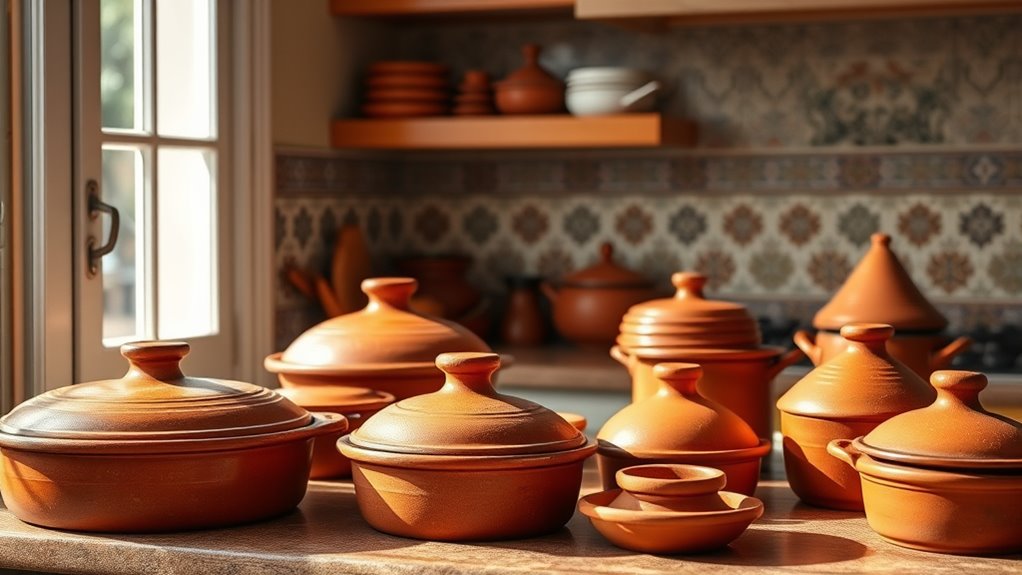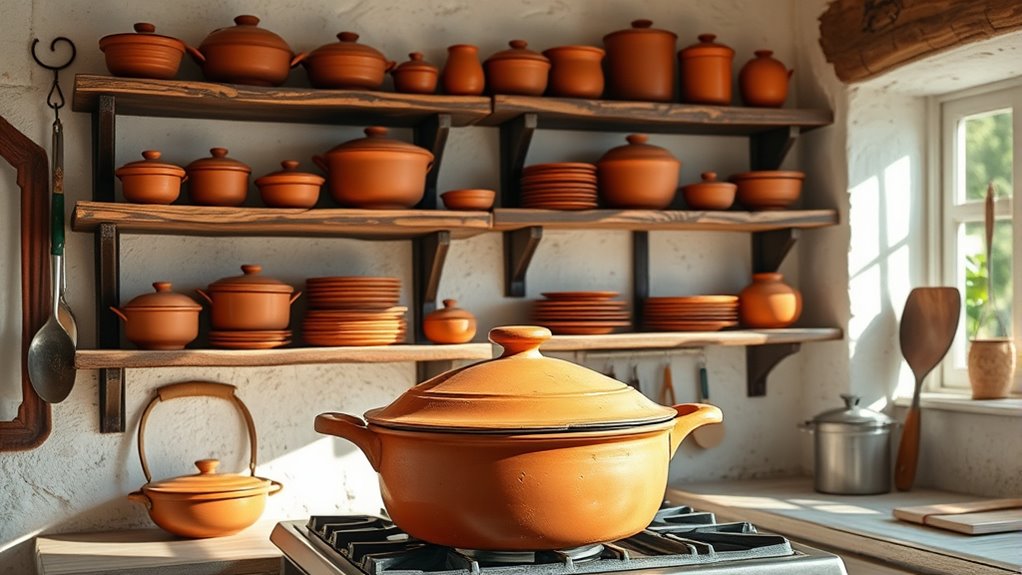In Italian kitchens, terracotta cookware plays a crucial role by enhancing authentic flavors and embracing centuries-old culinary traditions. Its natural material distributes heat evenly, perfect for slow-cooking and developing deep, rich tastes. The porous surface retains moisture, creating tender dishes full of flavor. Many families pass down their clay pots, preserving a timeless heritage. If you keep exploring, you’ll discover how this iconic cookware continues to shape Italy’s rich culinary culture.
Key Takeaways
- Terracotta cookware is deeply rooted in Italian culinary tradition, symbolizing authenticity and craftsmanship.
- Its natural clay composition provides durable, high-temperature resistant vessels for daily cooking.
- The even heat distribution enhances slow-cooked dishes, preserving flavors and moisture.
- Its porous nature allows flavor development and unique textures, vital for traditional Italian recipes.
- Proper maintenance and passing down generations preserve the cultural heritage and performance of terracotta cookware.

Have you ever wondered why terracotta cookware remains a staple in Italian kitchens? The answer lies in its remarkable clay pot durability and its deep connection to traditional cooking methods that have been passed down through generations. When you choose terracotta, you’re embracing a material that’s been trusted for centuries to deliver authentic flavors and time-honored culinary techniques. Unlike modern cookware, terracotta is made from natural clay, which makes it incredibly sturdy and capable of withstanding high temperatures. This resilience means it can handle the rigors of daily cooking without cracking or warping, making it a reliable choice for passionate home cooks and professional chefs alike.
Terracotta’s durability and traditional roots make it a trusted choice for authentic Italian cooking.
The strength of terracotta cookware isn’t just about its resilience; it’s also about how it enhances the cooking process. Because of its clay pot durability, it distributes heat slowly and evenly, which is essential for slow-cooked stews, braises, and roasts. When you place your dish inside a terracotta pot, you’re creating a stable environment that allows flavors to develop fully and ingredients to cook uniformly. This even heat distribution is a hallmark of traditional cooking methods, where patience and technique are key. It’s no coincidence that many authentic Italian recipes call for a clay pot—these methods preserve moisture, boost flavors, and produce tender results that are difficult to replicate with modern cookware.
Using terracotta also connects you to the rich culinary history of Italy. For centuries, Italian cooks have relied on these earthenware vessels for everything from hearty soups to delicate desserts. The porous nature of terracotta allows moisture to escape gently during cooking, which intensifies flavors and creates a unique texture that’s impossible to achieve with metal or glass. As you cook with terracotta, you’re not just preparing a meal; you’re participating in a centuries-old tradition that emphasizes simplicity, patience, and respect for ingredients. Additionally, clay pot durability enhances the longevity of the cookware, allowing it to be used and treasured for generations.
Furthermore, caring for terracotta cookware is straightforward, and with proper maintenance, its durability only improves over time. You’ll find that many Italian families pass down their clay pots, cherishing their ability to withstand the test of time while continuing to deliver exceptional results. Whether you’re simmering a ragu or baking bread, terracotta’s natural qualities support authentic culinary techniques rooted in tradition. By incorporating this cookware into your kitchen, you’re preserving a crucial aspect of Italian culinary heritage and elevating your cooking experience.
Frequently Asked Questions
How Do I Properly Season Terracotta Cookware?
To properly season terracotta cookware, start with the pre-seasoning process by washing it with warm water and gentle soap. Dry thoroughly, then apply a thin layer of cooking oil, such as vegetable or olive oil, all over the interior and exterior. Bake it in the oven at 350°F for about an hour. This helps create a natural non-stick coating and protects the cookware for future use.
Can Terracotta Cookware Be Used on Induction Stoves?
Oh, the joys of modern innovation—can your charming terracotta cookware embrace the sleek world of induction stoves? Sadly, most terracotta isn’t induction compatible because it lacks the magnetic properties needed for proper heat transfer. Its heat transfer properties are better suited for traditional methods. If you want to cook on induction, look for cookware with a ferromagnetic base; otherwise, enjoy your terracotta on gas or electric stoves.
What Are the Best Cleaning Methods for Terracotta Pots?
To keep your terracotta pots in top shape, follow simple cleaning tips and maintenance routines. After cooking, let the pot cool completely before washing with warm water and a soft brush. Avoid harsh soaps or abrasive scrubbers to preserve the surface. Occasionally, soak the pot in water to loosen residues. Regular cleaning and proper care make certain your terracotta cookware remains durable and enhances your cooking experience.
How Long Does Terracotta Cookware Typically Last?
Imagine your grandpa’s vintage radio—terracotta cookware can last just as long if you care for it properly. Its durability lifespan varies, but with good maintenance, it can serve you for decades. Material degradation happens slowly, especially with proper cleaning and seasoning. Typically, you can expect your terracotta pots to last 10-20 years or more, making them a worthwhile investment for hearty, traditional Italian dishes.
Are There Health Benefits to Cooking With Terracotta?
Cooking with terracotta offers some health benefits because it’s a natural material that minimally leaches minerals into your food. Unlike non-stick or metal options, terracotta’s porous surface allows for gentle heat distribution, which preserves nutrients. Plus, it’s free from harmful chemicals. While mineral leaching is minimal, it can add trace minerals to your dishes, making your meals slightly more nutritious and potentially healthier overall.
Conclusion
You see, terracotta cookware is like the heartbeat of Italian kitchens, bringing tradition and flavor to every dish. Its natural material heats evenly, much like a gentle hug for your food, enhancing taste and texture. By embracing terracotta, you connect with centuries of culinary heritage, making your cooking as warm and inviting as a family gathering. So, let this timeless cookware be your trusted partner in creating authentic Italian flavors that linger long after the meal’s over.









